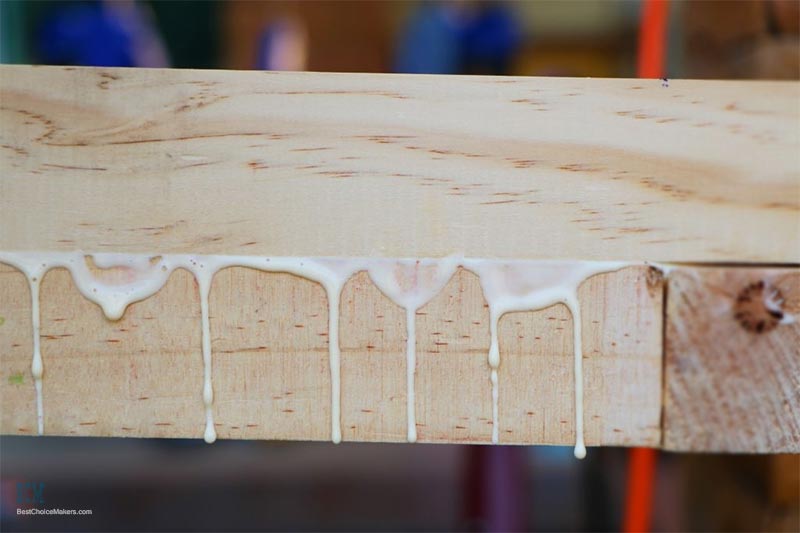
When working on a wooden piece, you won’t actually enjoy those moments of waiting to let that glue dry off. Because you’ll be constantly wanting to sand it and finish the project as soon as possible.
Things would have been much better if exactly how long does wood glue take to dry is within your knowledge. At least then you’ll know whether to wait since it’s pretty short. Or if it’s best to give the glue some time while you work on something else.
That’s what inspired me on writing today’s piece exactly, let’s find things out.
Exactly How Long Does It Take Wood Glue to Dry?
If you don’t want to make it much longer and get the exact wood glue dry time right away then let’s cut this short for now. As the most common rule of thumb, it’s best to leave things for at least 24 hours or one full day.
This is what it usually takes to dry off wood glue completely. If being safe is what you’d choose over being sorry, that’s a long but still the better bet you’d want to go for. Give the piece at least a day for it to dry fully before you get rid of those clamps.
Now there are some matters and factors that will interfere in this process. And because of the interference, two things could happen. Your piece will not be able to stick properly even after a day of clamping together. Or it may actually glue-up sooner than 24 hours. That’s exactly what we’ll be talking about in the next few paras.
The Longer but Useful Answer
You need to wait how long for wood glue to dry, is something that needs a few factors to check. And this includes matters related to your project of course. In some cases, you don’t need to waste your 24 hours unnecessarily. There are instants of glue drying within a half-hour of clamping or even less as well.
You can quickly sand the joints for giving it some stress on gluing together better. However, since joint is yet not completely strong, the sanding should be very light. Also, eventually the joint would need 24 hours to completely regain its strength to not detach any time sooner.
The factors that play a vital role in determining exactly how much longer you should be waiting in your case are something to know, however. Let’s talk about each of those below.
The Glue Bottle Instructions
The most basic thing one would do in using any sort of glue is checking instructions given on its bottle label. Yes, some wood glue does not include such information sadly, which is also a bit strange, to be honest. However, it’s true that sometimes you pick such bottles and that’s when the 24-hour waiting rule becomes even serious.
But if the glue bottle comes with a specific time period mentioned on it for waiting, there’s no need for you to roam around for a more obvious answer. Because the manufacturer will know best for such a case. You can fearlessly follow the instruction mentioned waiting period.
The Surrounding Temperature
Where you are working on the project, temperature on that spot has an impact on overall drying time. With higher temperatures, wood glues usually take less time to be fully dried.
However, if you live in a place where the climate is on colder side, it’ll take longer for your wood pieces to glue together. That’s another reason why sometimes even when you think it’s enough time and the glue must have dried by now, apparently it still isn’t.
Humidity is Another Critical Factor
Different level of humidity has some effect on a certain type of wood glue. For example, if you are using PVA glues, then it’ll dry quite faster with low humidity levels. While the polyurethane is quite okay with high moisture levels. As this type gets better at curing with such humidity circumstances.

The Type of Glue
Choosing the best wood Glue often means sticking pieces together firmly. And this one point is definitely way more critical to be choosey about. This sometimes makes people forget that choosing the glue based on how fast it dries off is also important. And that’s exactly what this whole point is about. Depending on which type of glue you choose for your project, drying time will vary accordingly.
- The first type is most readily available as well as easy in usage. The PVA or polyvinyl acetate adhesive is a wood glue that would take around 18 to 24 hours for drying completely. It needs at least half an hour of clamping as well.
- Also, there is hide glue which carpenters are more likely to use. These are available in both liquid and powdered granules formula. It needs at least 24 hours to completely dry. This one however doesn’t need a mandatory 30 minutes of clamping session.
- For outdoor projects, professionals usually reach out to epoxy glue. These are super-fast with dying. Usually, it won’t take more than 20 minutes. However, some of these may need a few hours to completely get dried.
- Then comes cyanoacrylate glue. The drying time for wood glue this time is between 8 to 24 hours. With these, you don’t need to worry about clamping as well. However, in case of bigger projects, it’s best to give the glue more time.
- And finally, polyurethane glue. This is also known as gorilla glue. It needs clamping for 2 hours as well as at least 24 hours for completely drying off.
How Can I Get Wood Glue to Dry Faster?
By following a few basic and easy tactics, you can make the glue drying period shorter. Here are the finest practices for such wishes.
Before actually buying the wood glue for whatever your project is, do some research on it. Figure out if it goes well with your drying time preference along with the quality.
When you check the instructions on glue bottle, be aware of both unstressed and stressed drying periods.
According to Titebond, people tend to forget about the clamping stress. That’s something you can utilize for shortening the drying time period.
Even if you continue working after gluing pieces for less time, the curing for sure needs at least a day. So, you must make use of the final made thing after 24 hours.
Wrap Up
How long does wood glue take to dry and factors behind it, you should be aware of the whole thing by now. Wood craftsmen can make excellent use of their time after getting an idea of the drying period. This does not only save you from waiting terribly long without any clue but also helps in determining a lot of other things related.
Hopefully, this piece of writing was able to help you with the proper information. Go Create Some Masterpieces, Good Luck!
This is Autem Decker. Main Author of ‘TheHomeDigs‘. You may not find her on the list of top 10 contemporary Canadian interior designers, but everyone who knows her says she was born to be an interior designer.
She makes her plan in her head and draws them in her years-old diary with a note in the corner. The way she plays with color and shape amazes us.
Connect Her On – Twitter